Creativity, Innovation and Design Thinking: An Analysis Essay
VerifiedAdded on 2022/09/18
|8
|2291
|21
Essay
AI Summary
This essay delves into the critical role of creativity, innovation, and design thinking in contemporary organizations. It begins by defining these concepts and highlighting their importance for business growth, sustainability, and wealth creation. The essay explores the interplay between creativity, innovation, and design thinking, supported by theories like disruptive innovation, design thinking, and open innovation. It then examines the impact of these concepts on organizational success, using examples such as Tesla, Google, and Apple to illustrate practical applications. The analysis includes discussions of how these companies implement design thinking, foster innovation, and adapt to market changes. The essay concludes by emphasizing the significance of employee contributions to the effective integration of creativity and innovation within organizations. Overall, the essay provides a comprehensive overview of how creativity, innovation, and design thinking are essential for achieving a competitive edge in today's business environment.
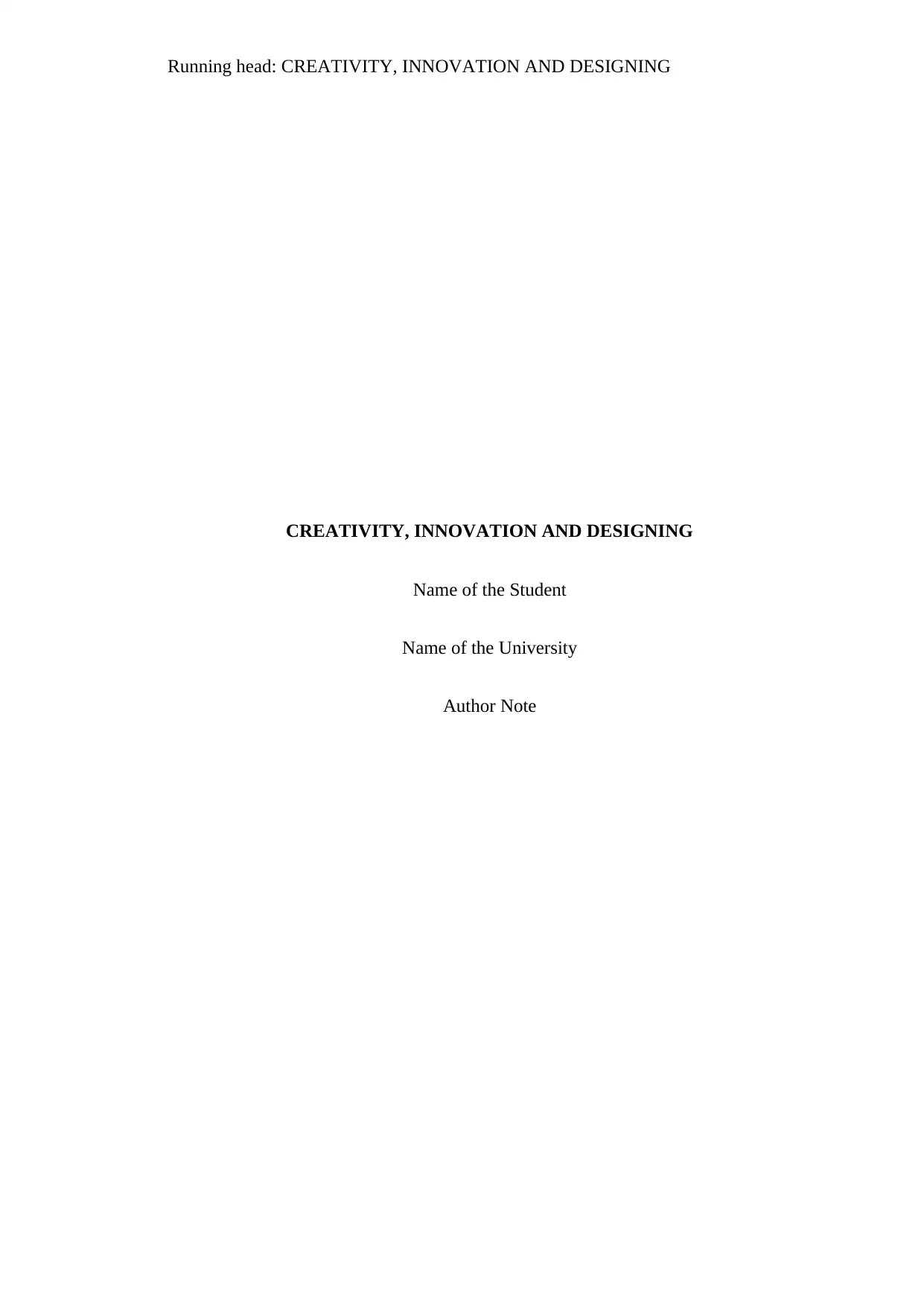
Running head: CREATIVITY, INNOVATION AND DESIGNING
CREATIVITY, INNOVATION AND DESIGNING
Name of the Student
Name of the University
Author Note
CREATIVITY, INNOVATION AND DESIGNING
Name of the Student
Name of the University
Author Note
Paraphrase This Document
Need a fresh take? Get an instant paraphrase of this document with our AI Paraphraser
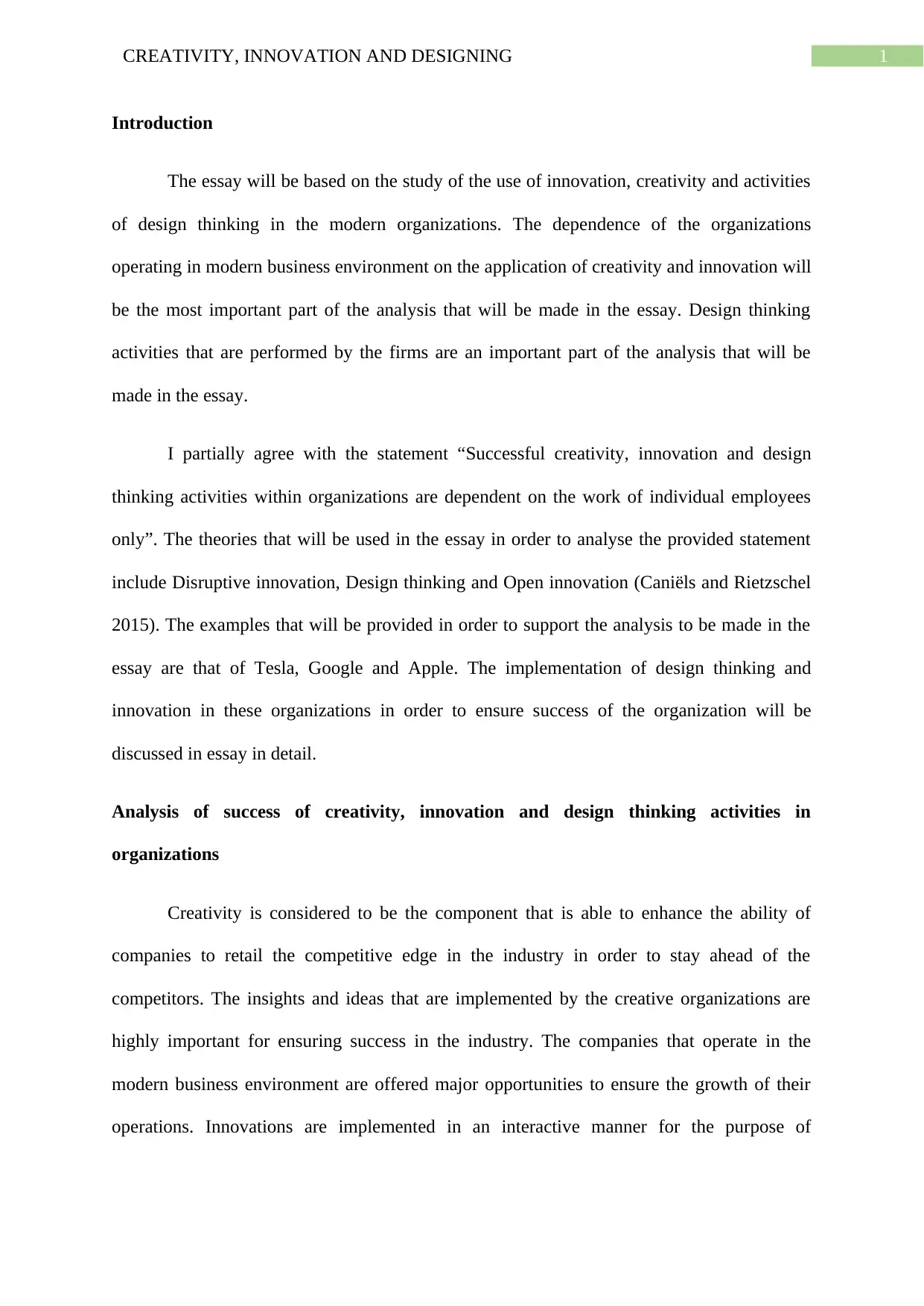
1CREATIVITY, INNOVATION AND DESIGNING
Introduction
The essay will be based on the study of the use of innovation, creativity and activities
of design thinking in the modern organizations. The dependence of the organizations
operating in modern business environment on the application of creativity and innovation will
be the most important part of the analysis that will be made in the essay. Design thinking
activities that are performed by the firms are an important part of the analysis that will be
made in the essay.
I partially agree with the statement “Successful creativity, innovation and design
thinking activities within organizations are dependent on the work of individual employees
only”. The theories that will be used in the essay in order to analyse the provided statement
include Disruptive innovation, Design thinking and Open innovation (Caniëls and Rietzschel
2015). The examples that will be provided in order to support the analysis to be made in the
essay are that of Tesla, Google and Apple. The implementation of design thinking and
innovation in these organizations in order to ensure success of the organization will be
discussed in essay in detail.
Analysis of success of creativity, innovation and design thinking activities in
organizations
Creativity is considered to be the component that is able to enhance the ability of
companies to retail the competitive edge in the industry in order to stay ahead of the
competitors. The insights and ideas that are implemented by the creative organizations are
highly important for ensuring success in the industry. The companies that operate in the
modern business environment are offered major opportunities to ensure the growth of their
operations. Innovations are implemented in an interactive manner for the purpose of
Introduction
The essay will be based on the study of the use of innovation, creativity and activities
of design thinking in the modern organizations. The dependence of the organizations
operating in modern business environment on the application of creativity and innovation will
be the most important part of the analysis that will be made in the essay. Design thinking
activities that are performed by the firms are an important part of the analysis that will be
made in the essay.
I partially agree with the statement “Successful creativity, innovation and design
thinking activities within organizations are dependent on the work of individual employees
only”. The theories that will be used in the essay in order to analyse the provided statement
include Disruptive innovation, Design thinking and Open innovation (Caniëls and Rietzschel
2015). The examples that will be provided in order to support the analysis to be made in the
essay are that of Tesla, Google and Apple. The implementation of design thinking and
innovation in these organizations in order to ensure success of the organization will be
discussed in essay in detail.
Analysis of success of creativity, innovation and design thinking activities in
organizations
Creativity is considered to be the component that is able to enhance the ability of
companies to retail the competitive edge in the industry in order to stay ahead of the
competitors. The insights and ideas that are implemented by the creative organizations are
highly important for ensuring success in the industry. The companies that operate in the
modern business environment are offered major opportunities to ensure the growth of their
operations. Innovations are implemented in an interactive manner for the purpose of
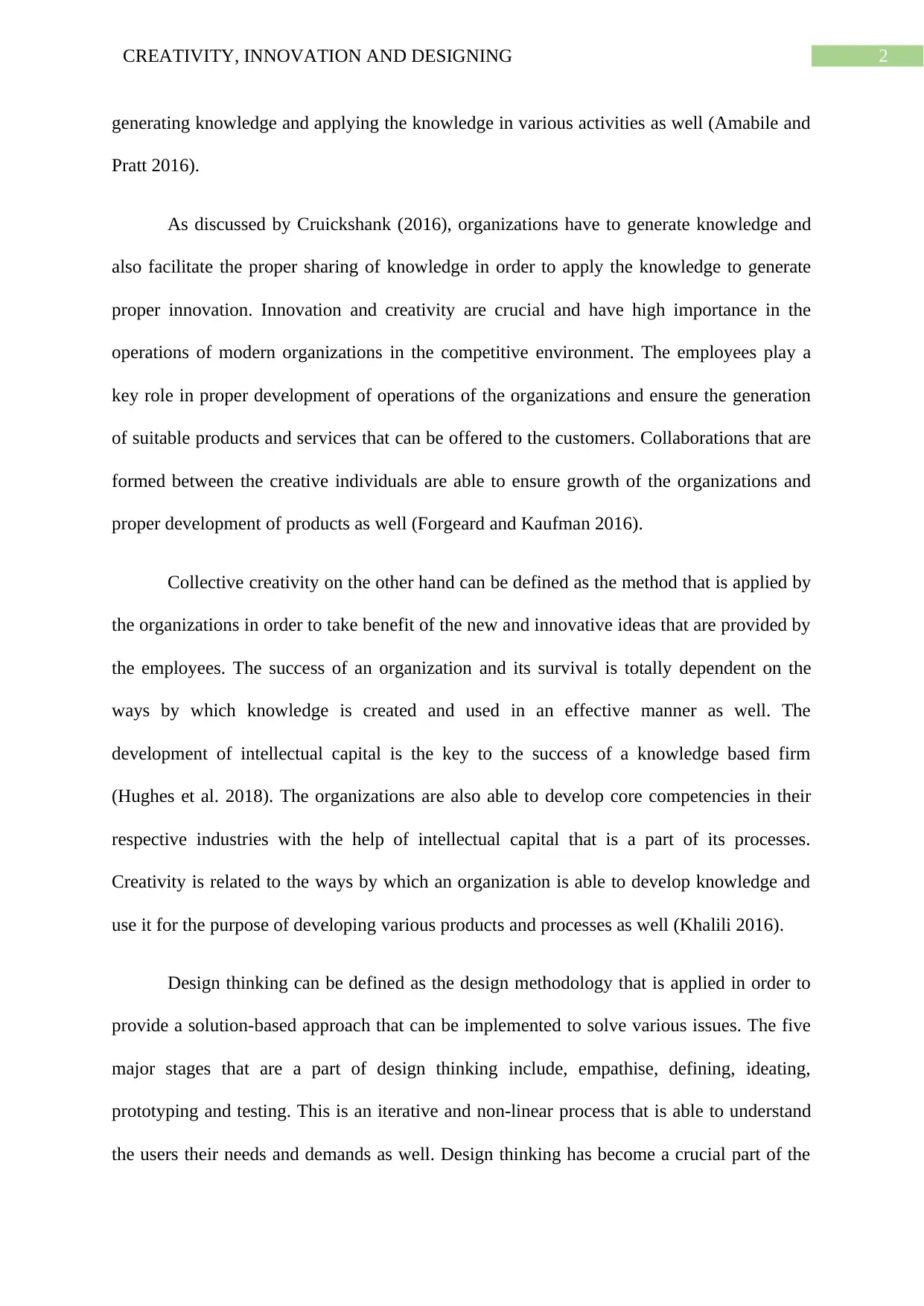
2CREATIVITY, INNOVATION AND DESIGNING
generating knowledge and applying the knowledge in various activities as well (Amabile and
Pratt 2016).
As discussed by Cruickshank (2016), organizations have to generate knowledge and
also facilitate the proper sharing of knowledge in order to apply the knowledge to generate
proper innovation. Innovation and creativity are crucial and have high importance in the
operations of modern organizations in the competitive environment. The employees play a
key role in proper development of operations of the organizations and ensure the generation
of suitable products and services that can be offered to the customers. Collaborations that are
formed between the creative individuals are able to ensure growth of the organizations and
proper development of products as well (Forgeard and Kaufman 2016).
Collective creativity on the other hand can be defined as the method that is applied by
the organizations in order to take benefit of the new and innovative ideas that are provided by
the employees. The success of an organization and its survival is totally dependent on the
ways by which knowledge is created and used in an effective manner as well. The
development of intellectual capital is the key to the success of a knowledge based firm
(Hughes et al. 2018). The organizations are also able to develop core competencies in their
respective industries with the help of intellectual capital that is a part of its processes.
Creativity is related to the ways by which an organization is able to develop knowledge and
use it for the purpose of developing various products and processes as well (Khalili 2016).
Design thinking can be defined as the design methodology that is applied in order to
provide a solution-based approach that can be implemented to solve various issues. The five
major stages that are a part of design thinking include, empathise, defining, ideating,
prototyping and testing. This is an iterative and non-linear process that is able to understand
the users their needs and demands as well. Design thinking has become a crucial part of the
generating knowledge and applying the knowledge in various activities as well (Amabile and
Pratt 2016).
As discussed by Cruickshank (2016), organizations have to generate knowledge and
also facilitate the proper sharing of knowledge in order to apply the knowledge to generate
proper innovation. Innovation and creativity are crucial and have high importance in the
operations of modern organizations in the competitive environment. The employees play a
key role in proper development of operations of the organizations and ensure the generation
of suitable products and services that can be offered to the customers. Collaborations that are
formed between the creative individuals are able to ensure growth of the organizations and
proper development of products as well (Forgeard and Kaufman 2016).
Collective creativity on the other hand can be defined as the method that is applied by
the organizations in order to take benefit of the new and innovative ideas that are provided by
the employees. The success of an organization and its survival is totally dependent on the
ways by which knowledge is created and used in an effective manner as well. The
development of intellectual capital is the key to the success of a knowledge based firm
(Hughes et al. 2018). The organizations are also able to develop core competencies in their
respective industries with the help of intellectual capital that is a part of its processes.
Creativity is related to the ways by which an organization is able to develop knowledge and
use it for the purpose of developing various products and processes as well (Khalili 2016).
Design thinking can be defined as the design methodology that is applied in order to
provide a solution-based approach that can be implemented to solve various issues. The five
major stages that are a part of design thinking include, empathise, defining, ideating,
prototyping and testing. This is an iterative and non-linear process that is able to understand
the users their needs and demands as well. Design thinking has become a crucial part of the
⊘ This is a preview!⊘
Do you want full access?
Subscribe today to unlock all pages.

Trusted by 1+ million students worldwide
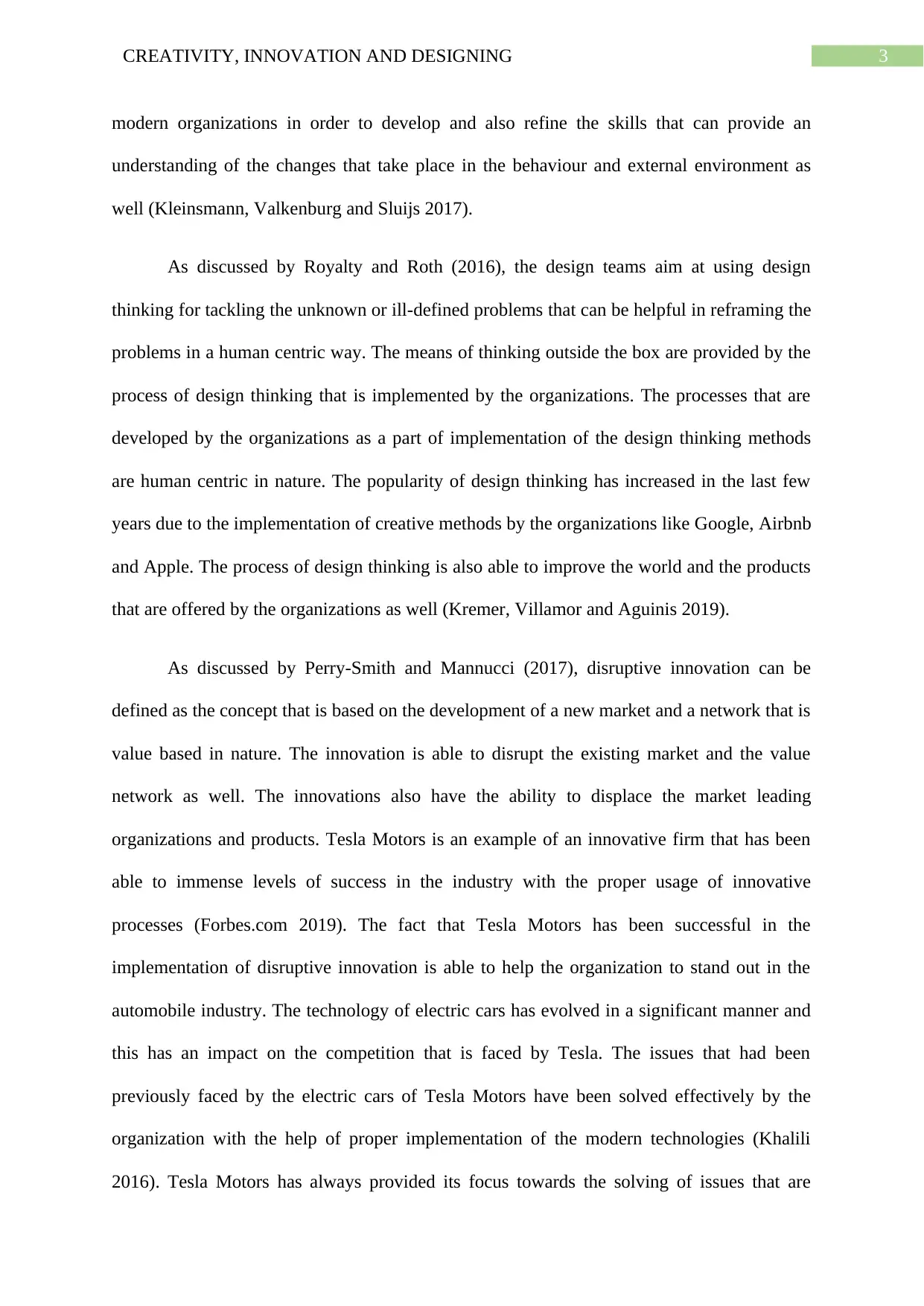
3CREATIVITY, INNOVATION AND DESIGNING
modern organizations in order to develop and also refine the skills that can provide an
understanding of the changes that take place in the behaviour and external environment as
well (Kleinsmann, Valkenburg and Sluijs 2017).
As discussed by Royalty and Roth (2016), the design teams aim at using design
thinking for tackling the unknown or ill-defined problems that can be helpful in reframing the
problems in a human centric way. The means of thinking outside the box are provided by the
process of design thinking that is implemented by the organizations. The processes that are
developed by the organizations as a part of implementation of the design thinking methods
are human centric in nature. The popularity of design thinking has increased in the last few
years due to the implementation of creative methods by the organizations like Google, Airbnb
and Apple. The process of design thinking is also able to improve the world and the products
that are offered by the organizations as well (Kremer, Villamor and Aguinis 2019).
As discussed by Perry-Smith and Mannucci (2017), disruptive innovation can be
defined as the concept that is based on the development of a new market and a network that is
value based in nature. The innovation is able to disrupt the existing market and the value
network as well. The innovations also have the ability to displace the market leading
organizations and products. Tesla Motors is an example of an innovative firm that has been
able to immense levels of success in the industry with the proper usage of innovative
processes (Forbes.com 2019). The fact that Tesla Motors has been successful in the
implementation of disruptive innovation is able to help the organization to stand out in the
automobile industry. The technology of electric cars has evolved in a significant manner and
this has an impact on the competition that is faced by Tesla. The issues that had been
previously faced by the electric cars of Tesla Motors have been solved effectively by the
organization with the help of proper implementation of the modern technologies (Khalili
2016). Tesla Motors has always provided its focus towards the solving of issues that are
modern organizations in order to develop and also refine the skills that can provide an
understanding of the changes that take place in the behaviour and external environment as
well (Kleinsmann, Valkenburg and Sluijs 2017).
As discussed by Royalty and Roth (2016), the design teams aim at using design
thinking for tackling the unknown or ill-defined problems that can be helpful in reframing the
problems in a human centric way. The means of thinking outside the box are provided by the
process of design thinking that is implemented by the organizations. The processes that are
developed by the organizations as a part of implementation of the design thinking methods
are human centric in nature. The popularity of design thinking has increased in the last few
years due to the implementation of creative methods by the organizations like Google, Airbnb
and Apple. The process of design thinking is also able to improve the world and the products
that are offered by the organizations as well (Kremer, Villamor and Aguinis 2019).
As discussed by Perry-Smith and Mannucci (2017), disruptive innovation can be
defined as the concept that is based on the development of a new market and a network that is
value based in nature. The innovation is able to disrupt the existing market and the value
network as well. The innovations also have the ability to displace the market leading
organizations and products. Tesla Motors is an example of an innovative firm that has been
able to immense levels of success in the industry with the proper usage of innovative
processes (Forbes.com 2019). The fact that Tesla Motors has been successful in the
implementation of disruptive innovation is able to help the organization to stand out in the
automobile industry. The technology of electric cars has evolved in a significant manner and
this has an impact on the competition that is faced by Tesla. The issues that had been
previously faced by the electric cars of Tesla Motors have been solved effectively by the
organization with the help of proper implementation of the modern technologies (Khalili
2016). Tesla Motors has always provided its focus towards the solving of issues that are
Paraphrase This Document
Need a fresh take? Get an instant paraphrase of this document with our AI Paraphraser
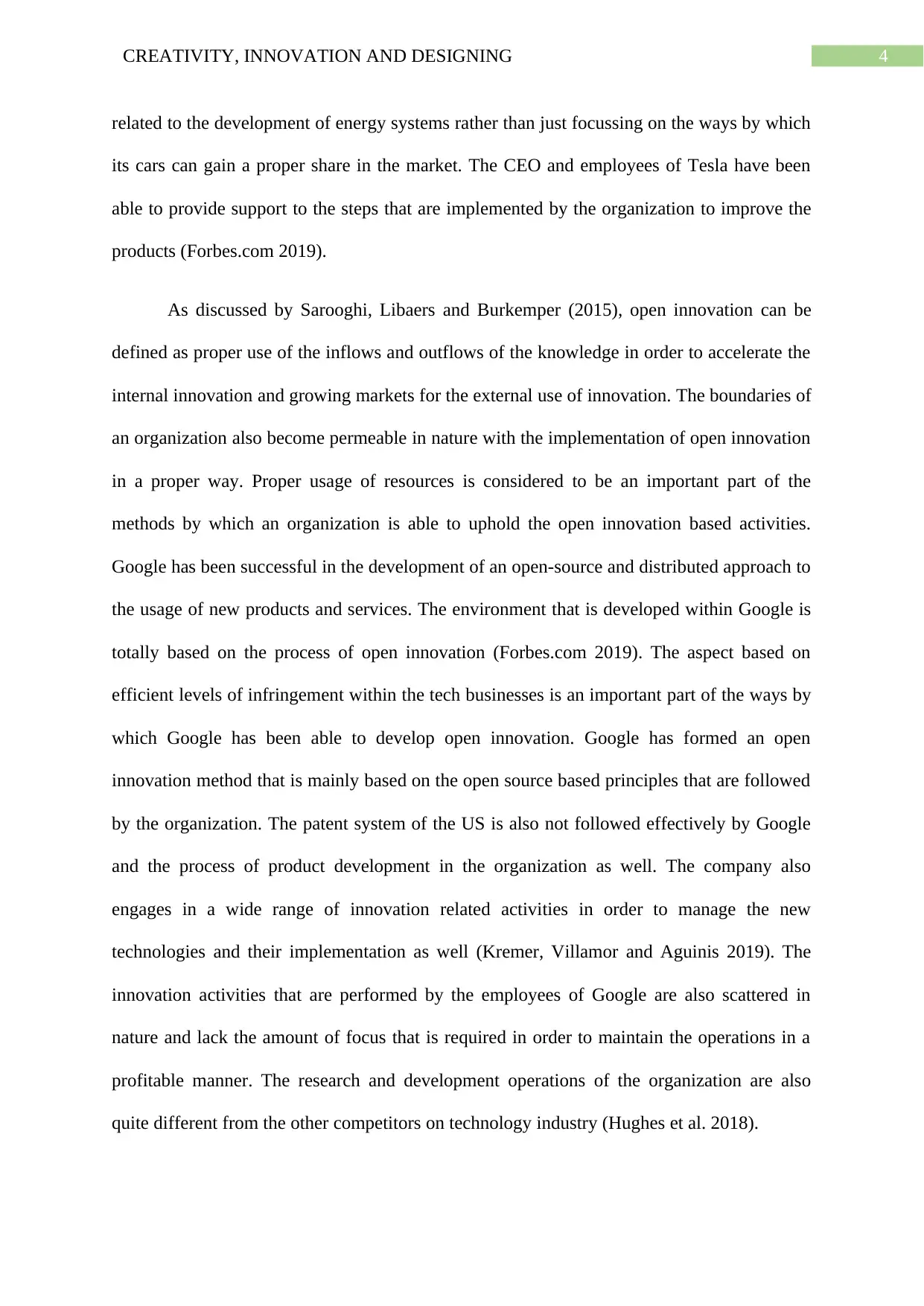
4CREATIVITY, INNOVATION AND DESIGNING
related to the development of energy systems rather than just focussing on the ways by which
its cars can gain a proper share in the market. The CEO and employees of Tesla have been
able to provide support to the steps that are implemented by the organization to improve the
products (Forbes.com 2019).
As discussed by Sarooghi, Libaers and Burkemper (2015), open innovation can be
defined as proper use of the inflows and outflows of the knowledge in order to accelerate the
internal innovation and growing markets for the external use of innovation. The boundaries of
an organization also become permeable in nature with the implementation of open innovation
in a proper way. Proper usage of resources is considered to be an important part of the
methods by which an organization is able to uphold the open innovation based activities.
Google has been successful in the development of an open-source and distributed approach to
the usage of new products and services. The environment that is developed within Google is
totally based on the process of open innovation (Forbes.com 2019). The aspect based on
efficient levels of infringement within the tech businesses is an important part of the ways by
which Google has been able to develop open innovation. Google has formed an open
innovation method that is mainly based on the open source based principles that are followed
by the organization. The patent system of the US is also not followed effectively by Google
and the process of product development in the organization as well. The company also
engages in a wide range of innovation related activities in order to manage the new
technologies and their implementation as well (Kremer, Villamor and Aguinis 2019). The
innovation activities that are performed by the employees of Google are also scattered in
nature and lack the amount of focus that is required in order to maintain the operations in a
profitable manner. The research and development operations of the organization are also
quite different from the other competitors on technology industry (Hughes et al. 2018).
related to the development of energy systems rather than just focussing on the ways by which
its cars can gain a proper share in the market. The CEO and employees of Tesla have been
able to provide support to the steps that are implemented by the organization to improve the
products (Forbes.com 2019).
As discussed by Sarooghi, Libaers and Burkemper (2015), open innovation can be
defined as proper use of the inflows and outflows of the knowledge in order to accelerate the
internal innovation and growing markets for the external use of innovation. The boundaries of
an organization also become permeable in nature with the implementation of open innovation
in a proper way. Proper usage of resources is considered to be an important part of the
methods by which an organization is able to uphold the open innovation based activities.
Google has been successful in the development of an open-source and distributed approach to
the usage of new products and services. The environment that is developed within Google is
totally based on the process of open innovation (Forbes.com 2019). The aspect based on
efficient levels of infringement within the tech businesses is an important part of the ways by
which Google has been able to develop open innovation. Google has formed an open
innovation method that is mainly based on the open source based principles that are followed
by the organization. The patent system of the US is also not followed effectively by Google
and the process of product development in the organization as well. The company also
engages in a wide range of innovation related activities in order to manage the new
technologies and their implementation as well (Kremer, Villamor and Aguinis 2019). The
innovation activities that are performed by the employees of Google are also scattered in
nature and lack the amount of focus that is required in order to maintain the operations in a
profitable manner. The research and development operations of the organization are also
quite different from the other competitors on technology industry (Hughes et al. 2018).
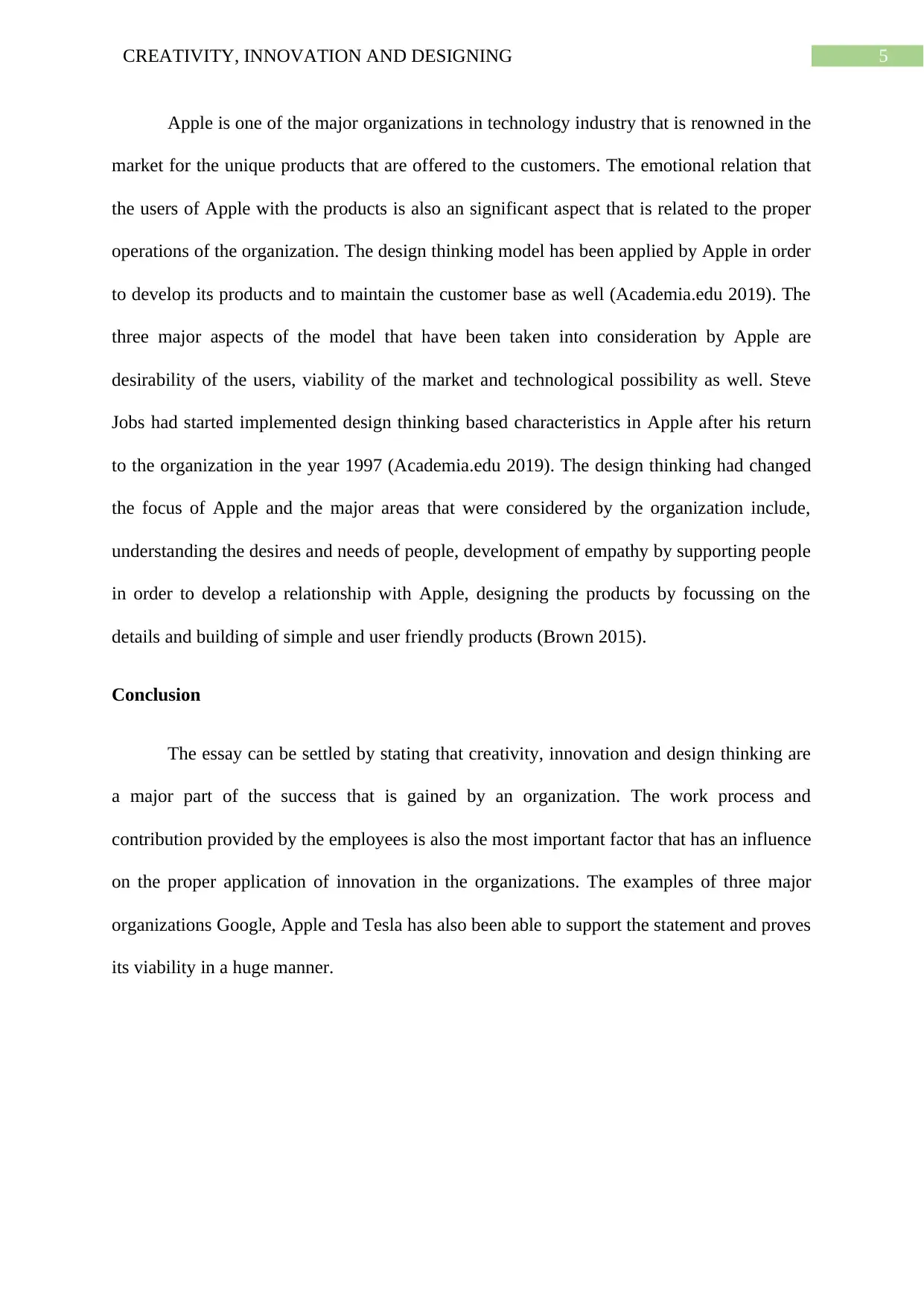
5CREATIVITY, INNOVATION AND DESIGNING
Apple is one of the major organizations in technology industry that is renowned in the
market for the unique products that are offered to the customers. The emotional relation that
the users of Apple with the products is also an significant aspect that is related to the proper
operations of the organization. The design thinking model has been applied by Apple in order
to develop its products and to maintain the customer base as well (Academia.edu 2019). The
three major aspects of the model that have been taken into consideration by Apple are
desirability of the users, viability of the market and technological possibility as well. Steve
Jobs had started implemented design thinking based characteristics in Apple after his return
to the organization in the year 1997 (Academia.edu 2019). The design thinking had changed
the focus of Apple and the major areas that were considered by the organization include,
understanding the desires and needs of people, development of empathy by supporting people
in order to develop a relationship with Apple, designing the products by focussing on the
details and building of simple and user friendly products (Brown 2015).
Conclusion
The essay can be settled by stating that creativity, innovation and design thinking are
a major part of the success that is gained by an organization. The work process and
contribution provided by the employees is also the most important factor that has an influence
on the proper application of innovation in the organizations. The examples of three major
organizations Google, Apple and Tesla has also been able to support the statement and proves
its viability in a huge manner.
Apple is one of the major organizations in technology industry that is renowned in the
market for the unique products that are offered to the customers. The emotional relation that
the users of Apple with the products is also an significant aspect that is related to the proper
operations of the organization. The design thinking model has been applied by Apple in order
to develop its products and to maintain the customer base as well (Academia.edu 2019). The
three major aspects of the model that have been taken into consideration by Apple are
desirability of the users, viability of the market and technological possibility as well. Steve
Jobs had started implemented design thinking based characteristics in Apple after his return
to the organization in the year 1997 (Academia.edu 2019). The design thinking had changed
the focus of Apple and the major areas that were considered by the organization include,
understanding the desires and needs of people, development of empathy by supporting people
in order to develop a relationship with Apple, designing the products by focussing on the
details and building of simple and user friendly products (Brown 2015).
Conclusion
The essay can be settled by stating that creativity, innovation and design thinking are
a major part of the success that is gained by an organization. The work process and
contribution provided by the employees is also the most important factor that has an influence
on the proper application of innovation in the organizations. The examples of three major
organizations Google, Apple and Tesla has also been able to support the statement and proves
its viability in a huge manner.
⊘ This is a preview!⊘
Do you want full access?
Subscribe today to unlock all pages.

Trusted by 1+ million students worldwide
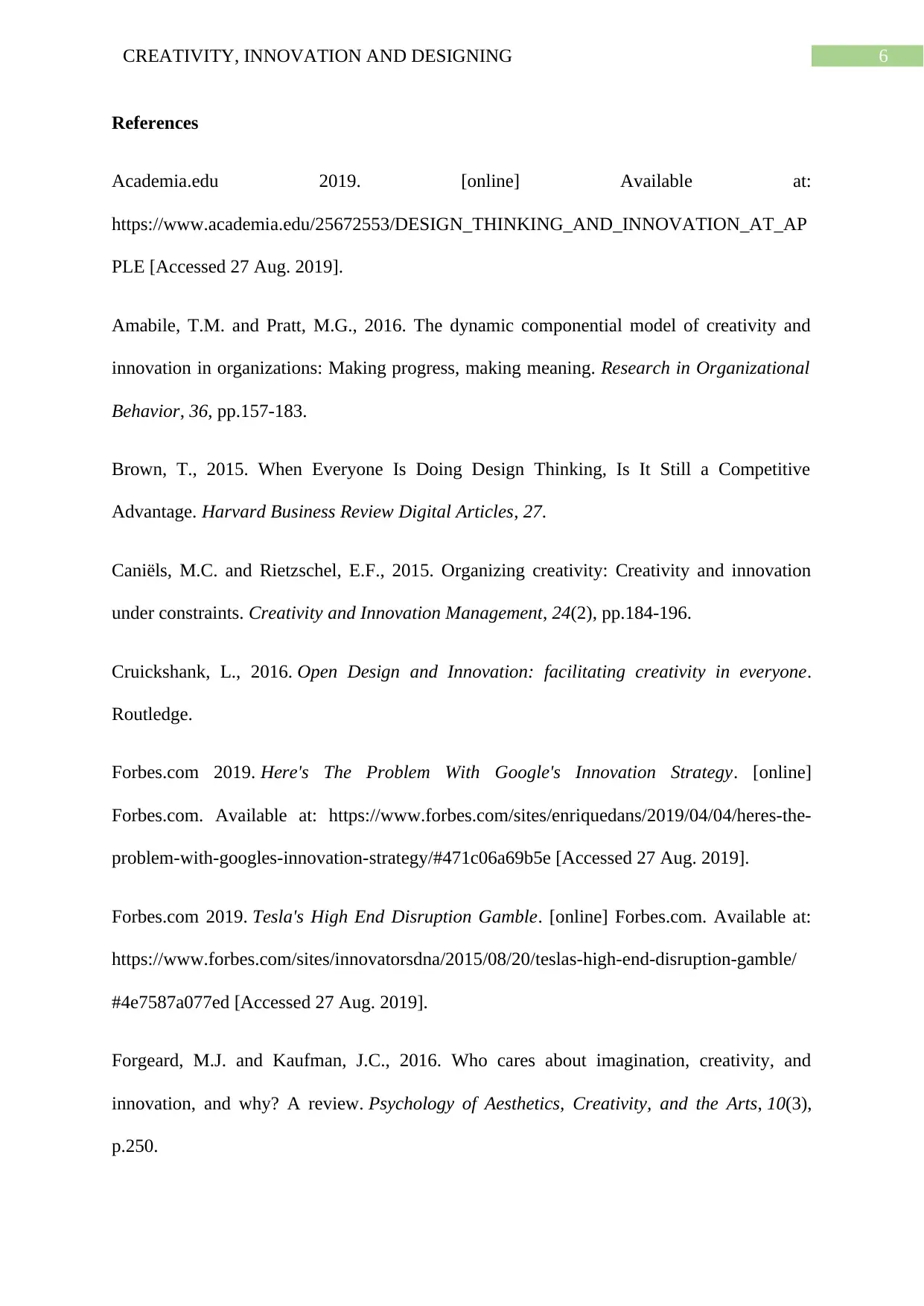
6CREATIVITY, INNOVATION AND DESIGNING
References
Academia.edu 2019. [online] Available at:
https://www.academia.edu/25672553/DESIGN_THINKING_AND_INNOVATION_AT_AP
PLE [Accessed 27 Aug. 2019].
Amabile, T.M. and Pratt, M.G., 2016. The dynamic componential model of creativity and
innovation in organizations: Making progress, making meaning. Research in Organizational
Behavior, 36, pp.157-183.
Brown, T., 2015. When Everyone Is Doing Design Thinking, Is It Still a Competitive
Advantage. Harvard Business Review Digital Articles, 27.
Caniëls, M.C. and Rietzschel, E.F., 2015. Organizing creativity: Creativity and innovation
under constraints. Creativity and Innovation Management, 24(2), pp.184-196.
Cruickshank, L., 2016. Open Design and Innovation: facilitating creativity in everyone.
Routledge.
Forbes.com 2019. Here's The Problem With Google's Innovation Strategy. [online]
Forbes.com. Available at: https://www.forbes.com/sites/enriquedans/2019/04/04/heres-the-
problem-with-googles-innovation-strategy/#471c06a69b5e [Accessed 27 Aug. 2019].
Forbes.com 2019. Tesla's High End Disruption Gamble. [online] Forbes.com. Available at:
https://www.forbes.com/sites/innovatorsdna/2015/08/20/teslas-high-end-disruption-gamble/
#4e7587a077ed [Accessed 27 Aug. 2019].
Forgeard, M.J. and Kaufman, J.C., 2016. Who cares about imagination, creativity, and
innovation, and why? A review. Psychology of Aesthetics, Creativity, and the Arts, 10(3),
p.250.
References
Academia.edu 2019. [online] Available at:
https://www.academia.edu/25672553/DESIGN_THINKING_AND_INNOVATION_AT_AP
PLE [Accessed 27 Aug. 2019].
Amabile, T.M. and Pratt, M.G., 2016. The dynamic componential model of creativity and
innovation in organizations: Making progress, making meaning. Research in Organizational
Behavior, 36, pp.157-183.
Brown, T., 2015. When Everyone Is Doing Design Thinking, Is It Still a Competitive
Advantage. Harvard Business Review Digital Articles, 27.
Caniëls, M.C. and Rietzschel, E.F., 2015. Organizing creativity: Creativity and innovation
under constraints. Creativity and Innovation Management, 24(2), pp.184-196.
Cruickshank, L., 2016. Open Design and Innovation: facilitating creativity in everyone.
Routledge.
Forbes.com 2019. Here's The Problem With Google's Innovation Strategy. [online]
Forbes.com. Available at: https://www.forbes.com/sites/enriquedans/2019/04/04/heres-the-
problem-with-googles-innovation-strategy/#471c06a69b5e [Accessed 27 Aug. 2019].
Forbes.com 2019. Tesla's High End Disruption Gamble. [online] Forbes.com. Available at:
https://www.forbes.com/sites/innovatorsdna/2015/08/20/teslas-high-end-disruption-gamble/
#4e7587a077ed [Accessed 27 Aug. 2019].
Forgeard, M.J. and Kaufman, J.C., 2016. Who cares about imagination, creativity, and
innovation, and why? A review. Psychology of Aesthetics, Creativity, and the Arts, 10(3),
p.250.
Paraphrase This Document
Need a fresh take? Get an instant paraphrase of this document with our AI Paraphraser
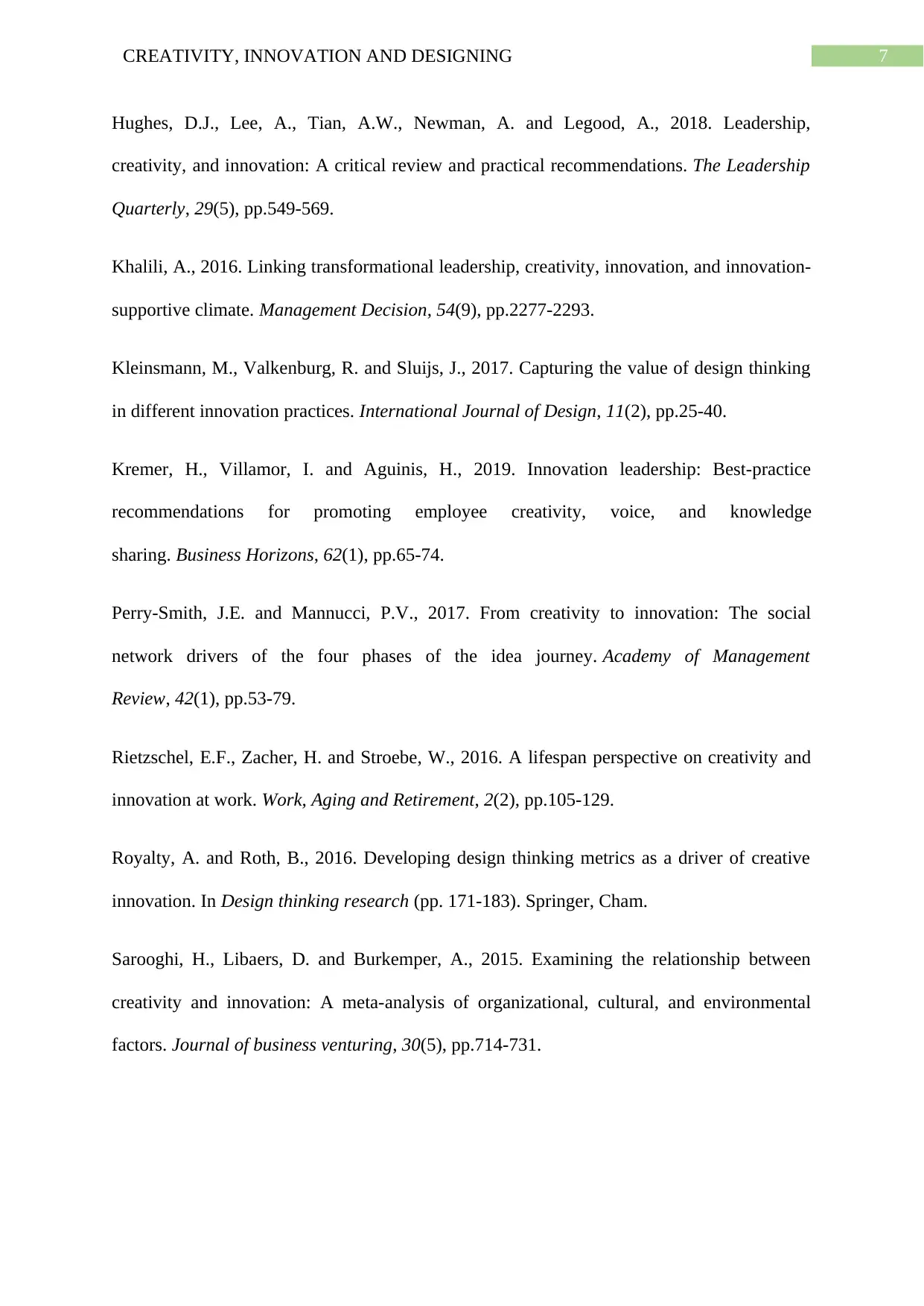
7CREATIVITY, INNOVATION AND DESIGNING
Hughes, D.J., Lee, A., Tian, A.W., Newman, A. and Legood, A., 2018. Leadership,
creativity, and innovation: A critical review and practical recommendations. The Leadership
Quarterly, 29(5), pp.549-569.
Khalili, A., 2016. Linking transformational leadership, creativity, innovation, and innovation-
supportive climate. Management Decision, 54(9), pp.2277-2293.
Kleinsmann, M., Valkenburg, R. and Sluijs, J., 2017. Capturing the value of design thinking
in different innovation practices. International Journal of Design, 11(2), pp.25-40.
Kremer, H., Villamor, I. and Aguinis, H., 2019. Innovation leadership: Best-practice
recommendations for promoting employee creativity, voice, and knowledge
sharing. Business Horizons, 62(1), pp.65-74.
Perry-Smith, J.E. and Mannucci, P.V., 2017. From creativity to innovation: The social
network drivers of the four phases of the idea journey. Academy of Management
Review, 42(1), pp.53-79.
Rietzschel, E.F., Zacher, H. and Stroebe, W., 2016. A lifespan perspective on creativity and
innovation at work. Work, Aging and Retirement, 2(2), pp.105-129.
Royalty, A. and Roth, B., 2016. Developing design thinking metrics as a driver of creative
innovation. In Design thinking research (pp. 171-183). Springer, Cham.
Sarooghi, H., Libaers, D. and Burkemper, A., 2015. Examining the relationship between
creativity and innovation: A meta-analysis of organizational, cultural, and environmental
factors. Journal of business venturing, 30(5), pp.714-731.
Hughes, D.J., Lee, A., Tian, A.W., Newman, A. and Legood, A., 2018. Leadership,
creativity, and innovation: A critical review and practical recommendations. The Leadership
Quarterly, 29(5), pp.549-569.
Khalili, A., 2016. Linking transformational leadership, creativity, innovation, and innovation-
supportive climate. Management Decision, 54(9), pp.2277-2293.
Kleinsmann, M., Valkenburg, R. and Sluijs, J., 2017. Capturing the value of design thinking
in different innovation practices. International Journal of Design, 11(2), pp.25-40.
Kremer, H., Villamor, I. and Aguinis, H., 2019. Innovation leadership: Best-practice
recommendations for promoting employee creativity, voice, and knowledge
sharing. Business Horizons, 62(1), pp.65-74.
Perry-Smith, J.E. and Mannucci, P.V., 2017. From creativity to innovation: The social
network drivers of the four phases of the idea journey. Academy of Management
Review, 42(1), pp.53-79.
Rietzschel, E.F., Zacher, H. and Stroebe, W., 2016. A lifespan perspective on creativity and
innovation at work. Work, Aging and Retirement, 2(2), pp.105-129.
Royalty, A. and Roth, B., 2016. Developing design thinking metrics as a driver of creative
innovation. In Design thinking research (pp. 171-183). Springer, Cham.
Sarooghi, H., Libaers, D. and Burkemper, A., 2015. Examining the relationship between
creativity and innovation: A meta-analysis of organizational, cultural, and environmental
factors. Journal of business venturing, 30(5), pp.714-731.
1 out of 8
Related Documents
Your All-in-One AI-Powered Toolkit for Academic Success.
+13062052269
info@desklib.com
Available 24*7 on WhatsApp / Email
![[object Object]](/_next/static/media/star-bottom.7253800d.svg)
Unlock your academic potential
Copyright © 2020–2025 A2Z Services. All Rights Reserved. Developed and managed by ZUCOL.





